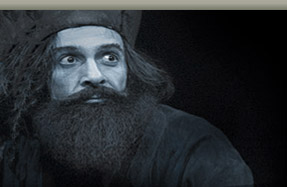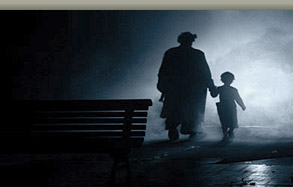





![]()
2. VARIA

2.7 · MIRANDO HACIA ATRÁS PARA SEGUIR ADELANTE: LA PUESTA EN ESCENA DE LA COMEDIA EN LA ESPAÑA CONTEMPORÁNEA Y LA CREACIÓN DE UN LOPE PARA EL SIGLO XXI
Por Duncan Wheeler
Obras citadas
BALTÉS, Blanca (2011). Historia de la dirección de escena en España: Cayetano Luca de Tena, 1941-1991, Tesis inédita., Univ. Complutense.
BRIOSO, Héctor (2007). “Del arte nuevo de hacer comedias en este tiempo o la adaptación del teatro clásico a la escena teatral”, en Nuevas aportaciones a los estudios teatrales (del Siglo de Oro a nuestros días), ed. Héctor Brioso y José V. Saval, (Alcalá: Universidad de Alcalá), 11-24.
BROOK, Peter (1993). There Are No Secrets: Thoughts on Acting and Theatre (London: Methuen).
DORAN, Gregory (2012). Shakespeare’s Lost Play: In Search of Cardenio (London: Nick Hern Books).
G. FELDMAN, Sharon y Anxo ABUÍN GONZÁLEZ (2012). “Nationalism, identity and the theatre across the Spanish state in the democratic era, 1975–2010”, en A History of Theatre in Spain, ed. María M. Delgado y David T. Gies, (Cambridge: Cambridge University Press), 391-425.
FRAGA IRIBARNE, Manuel (1965). Horizonte español (Madrid: Editora Nacional).
GARCÍA SANTO-TOMÁS, Enrique (2000). La creación del Fénix: recepción crítica y formación canónica del teatro de Lope de Vega (Madrid: Gredos).
HERA, Alberto de la (2003). “Cualquier parecido…es que no hay ningún parecido”, Guía del Ocio (Madrid), 7 Feb.: 114.
KOTT, Jan (1967). Shakespeare Our Contemporary, 2nd ed, (London: Methuen and Co).
LUCA DE TENA, Cayetano (1953). “Ensayo general: notas, experiencias y fracasos de un director de escena, III”, Teatro, 3: 45-8.
MUÑOZ CARABANTES, Manuel (1992). “Puesta en escena y recepción del teatro clásico y medieval en España desde 1939 a nuestros días”, Tesis inédita., U Complutense.
PÉREZ-RASILLA, Eduardo (2008). “La puesta en escena de los clásicos. La crítica académica”, Acotaciones: revista de investigación teatral, 20: 9-22.
THACKER, Jonathan (2004). “‘Puedo yo con sola la vista oír leyendo’, reading, seeing and hearing the comedia”, Comedia Performance, 1.1: 143-73.
WHEELER, Duncan. (2007). “We are living in a material world and I am a material girl: Diana, Countess of Belflor materialised on the page, stage and screen”, Bulletin of Hispanic Studies, 84.3: 267-86.
___ (2009). “La presencia del teatro español en la cartelera inglesa durante el siglo XXI”, Contraviento, 8: 18-21.
___ (2011a). “Beyond the black legend of Calderón´s wife murder-plays: amorous strife, violence and the comedia”, en On Wolves and Sheep: Exploring the Expression of Political Thought in Golden Age Spain, ed. Aaron M. Kahn, (Newcastle: Cambridge Scholars Publishing), 113-46.
___ (2011b). “From the town with more theaters than taxis: Calderón, Lope and Tirso at the 2008 Almagro Festival (part one)”, Comedia Performance, 8.1: 151-200.
___ (2011c). “¿La película duende?; María Teresa León, Rafael Alberti and alternative traditions of resurrecting Golden Age drama”, en Stages of Exile, ed. Helena Buffery, (Bern: Peter Lang), 71-93.
___ (2012a). “Contextualising and contesting José Antonio Maravall’s theories of baroque culture from the perspective of modern-day performance”, Bulletin of the Comediantes, 64.1: en prensa.
___ (2012b). “From the town with more theaters than taxis: Calderón, Lope and Tirso at the 2008 Almagro Festival (part two)”, Comedia Performance, 9.1: 102-42.
___ (2012c). Golden Age Drama in Contemporary Spain: The Comedia on Page, Stage and Screen (Cardiff: University of Wales Press).
___ (2013). “Pepe Estruch and the performance of Golden Age drama: A case study of international relationships under Franco, and their influence on democratic theatrical cultures”, en Remaking the Comedia: Spanish Classical Theater in Adaptation, eds. Susan Paun de García y Harley Erdman(Woodbridge: Tamesis), en prensa.
![]()

![]()

Don Galán. Revista audiovisual de investigación teatral. | cdt@inaem.mecd.es | ISSN: 2174-713X | NIPO: 035-12-018-3
2013 Centro de Documentación Teatral. INAEM. Ministerio de Educación, Cultura y Deporte. Gobierno de España. | Diseño Web: Toma10
Portada | Consejo de Redacción | Comité Científico | Normas de Publicación | Contacto | Enlaces